英语中八种常见时态常用时间状语归纳
- 格式:docx
- 大小:123.82 KB
- 文档页数:4
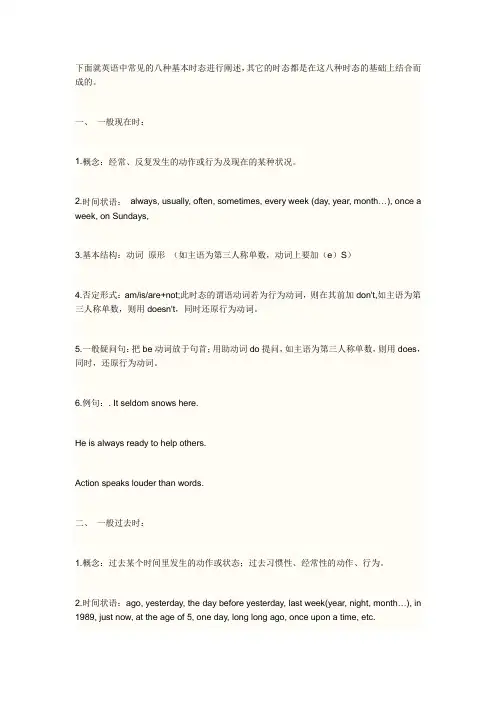
下面就英语中常见的八种基本时态进行阐述,其它的时态都是在这八种时态的基础上结合而成的。
一、一般现在时:1.概念:经常、反复发生的动作或行为及现在的某种状况。
2.时间状语:always, usually, often, sometimes, every week (day, year, month…), once a week, on Sundays,3.基本结构:动词原形(如主语为第三人称单数,动词上要加(e)S)4.否定形式:am/is/are+not;此时态的谓语动词若为行为动词,则在其前加don't,如主语为第三人称单数,则用doesn't,同时还原行为动词。
5.一般疑问句:把be动词放于句首;用助动词do提问,如主语为第三人称单数,则用does,同时,还原行为动词。
6.例句:. It seldom snows here.He is always ready to help others.Action speaks louder than words.二、一般过去时:1.概念:过去某个时间里发生的动作或状态;过去习惯性、经常性的动作、行为。
2.时间状语:ago, yesterday, the day before yesterday, last week(year, night, month…), in 1989, just now, at the age of 5, one day, long long ago, once upon a time, etc.3.基本结构:be动词;行为动词4.否定形式:was/were+not;在行为动词前加didn't,同时还原行为动词。
5.一般疑问句:was或were放于句首;用助动词do的过去式did 提问,同时还原行为动词。
6.例句:She often came to help us in those days.I didn't know you were so busy.三、现在进行时:1.概念:表示现阶段或说话时正在进行的动作及行为。
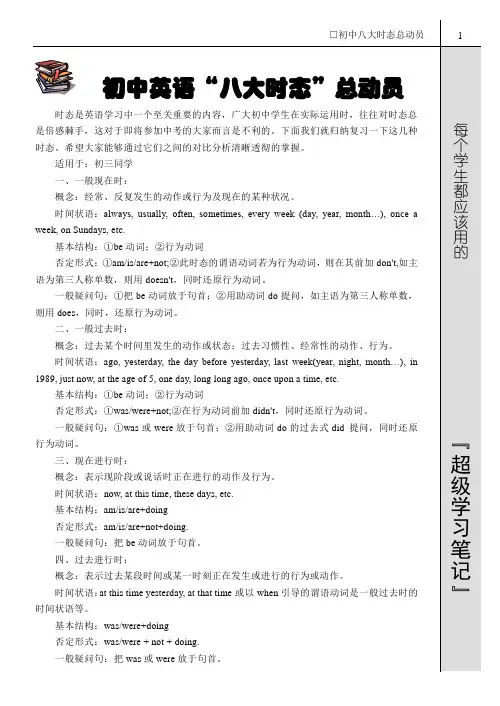
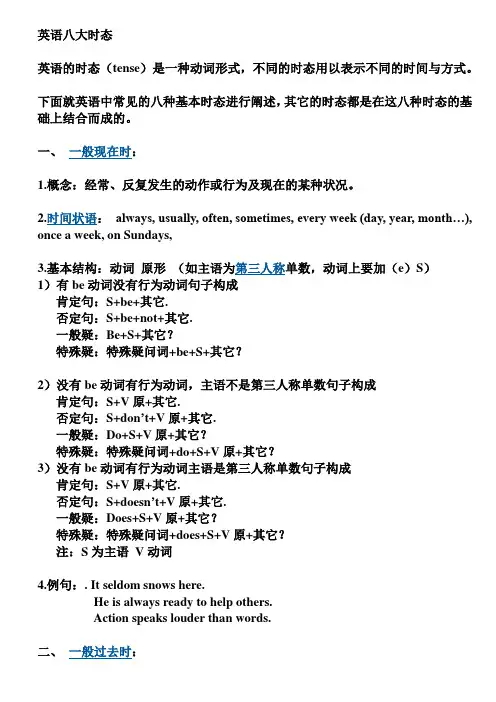
英语八大时态英语的时态(tense)是一种动词形式,不同的时态用以表示不同的时间与方式。
下面就英语中常见的八种基本时态进行阐述,其它的时态都是在这八种时态的基础上结合而成的。
一、一般现在时:1.概念:经常、反复发生的动作或行为及现在的某种状况。
2.时间状语:always, usually, often, sometimes, every week (day, year, month…), once a week, on Sundays,3.基本结构:动词原形(如主语为第三人称单数,动词上要加(e)S)1)有be动词没有行为动词句子构成肯定句:S+be+其它.否定句:S+be+not+其它.一般疑:Be+S+其它?特殊疑:特殊疑问词+be+S+其它?2)没有be动词有行为动词,主语不是第三人称单数句子构成肯定句:S+V原+其它.否定句:S+don’t+V原+其它.一般疑:Do+S+V原+其它?特殊疑:特殊疑问词+do+S+V原+其它?3)没有be动词有行为动词主语是第三人称单数句子构成肯定句:S+V原+其它.否定句:S+doesn’t+V原+其它.一般疑:Does+S+V原+其它?特殊疑:特殊疑问词+does+S+V原+其它?注:S为主语V动词4.例句:. It seldom snows here.He is always ready to help others.Action speaks louder than words.1.概念:过去某个时间里发生的动作或状态;过去习惯性、经常性的动作、行为。
2.时间状语:ago, yesterday, the day before yesterday, last week(year, night, month…), in 1989, just now, at the age of 5, one day, long long ago, once upon a time, etc.3.基本结构:be动词;行为动词1)有be动词没有行为动词句子构成肯定句:S+was/were+其它.否定句:S+was/were+not+其它.一般疑:Was/Were+S+其它?特殊疑:特殊疑问词+ was/were +S+其它?2) 没有be动词有行为动词句子构成肯定句:S+Ved+其它.否定句:S+didn’t+V原+其它.一般疑:Did+S+V原+其它?特殊疑:特殊疑问词+did+S+V原+其它?6.例句:She often came to help us in those days.I didn't know you were so busy.三、现在进行时:1.概念:表示现阶段或说话时正在进行的动作及行为。
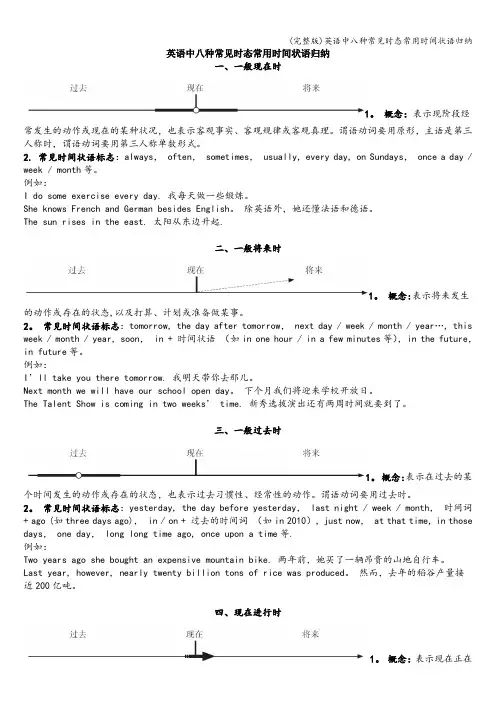
英语中八种常见时态常用时间状语归纳一、一般现在时1。
概念:表示现阶段经常发生的动作或现在的某种状况,也表示客观事实、客观规律或客观真理。
谓语动词要用原形,主语是第三人称时,谓语动词要用第三人称单数形式。
2. 常见时间状语标志:always, often, sometimes, usually, every day, on Sundays, once a day / week / month等。
例如:I do some exercise every day. 我每天做一些锻炼。
She knows French and German besides English。
除英语外,她还懂法语和德语。
The sun rises in the east. 太阳从东边升起.二、一般将来时1。
概念:表示将来发生的动作或存在的状态,以及打算、计划或准备做某事。
2。
常见时间状语标志:tomorrow, the day after tomorrow,next day / week / month / year…, this week / month / year, soon, in + 时间状语(如in one hour / in a few minutes等),in the future,in future等。
例如:I’ll take you there tomorrow. 我明天带你去那儿。
Next month we will have our school open day。
下个月我们将迎来学校开放日。
The Talent Show is coming in two weeks’ time. 新秀选拔演出还有两周时间就要到了。
三、一般过去时1。
概念:表示在过去的某个时间发生的动作或存在的状态,也表示过去习惯性、经常性的动作。
谓语动词要用过去时。
2。
常见时间状语标志:yesterday, the day before yesterday, last night / week / month,时间词+ ago (如three days ago), in / on + 过去的时间词(如in 2010), just now, at that time, in those days, one day, long long time ago, once upon a time等.例如:Two years ago she bought an expensive mountain bike. 两年前,她买了一辆昂贵的山地自行车。
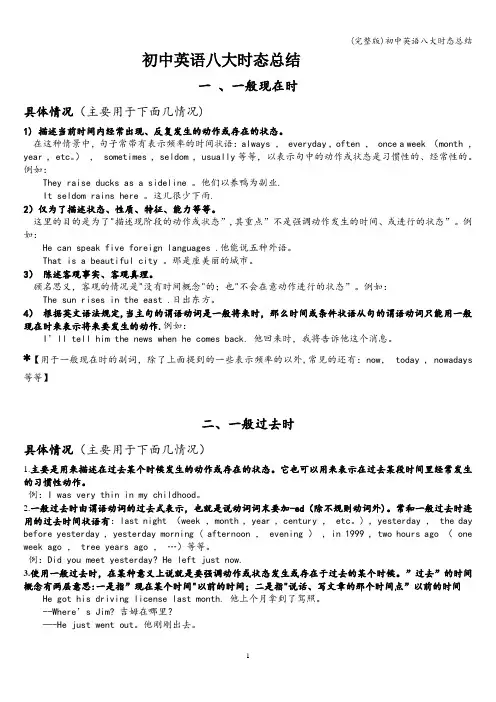
初中英语八大时态总结一、一般现在时具体情况(主要用于下面几情况)1) 描述当前时间内经常出现、反复发生的动作或存在的状态。
在这种情景中,句子常带有表示频率的时间状语:always , everyday , often , once a week (month ,year , etc。
), sometimes , seldom , usually等等,以表示句中的动作或状态是习惯性的、经常性的。
例如:They raise ducks as a sideline 。
他们以养鸭为副业.It seldom rains here 。
这儿很少下雨.2)仅为了描述状态、性质、特征、能力等等。
这里的目的是为了"描述现阶段的动作或状态”,其重点”不是强调动作发生的时间、或进行的状态”。
例如:He can speak five foreign languages .他能说五种外语。
That is a beautiful city 。
那是座美丽的城市。
3)陈述客观事实、客观真理。
顾名思义,客观的情况是"没有时间概念"的;也"不会在意动作进行的状态”。
例如:The sun rises in the east .日出东方。
4)根据英文语法规定,当主句的谓语动词是一般将来时,那么时间或条件状语从句的谓语动词只能用一般现在时来表示将来要发生的动作.例如:I’ll tell him the news when he comes back. 他回来时,我将告诉他这个消息。
*【用于一般现在时的副词,除了上面提到的一些表示频率的以外,常见的还有:now, today , nowadays 等等】二、一般过去时具体情况(主要用于下面几情况)1.主要是用来描述在过去某个时候发生的动作或存在的状态。
它也可以用来表示在过去某段时间里经常发生的习惯性动作。
例:I was very thin in my childhood。
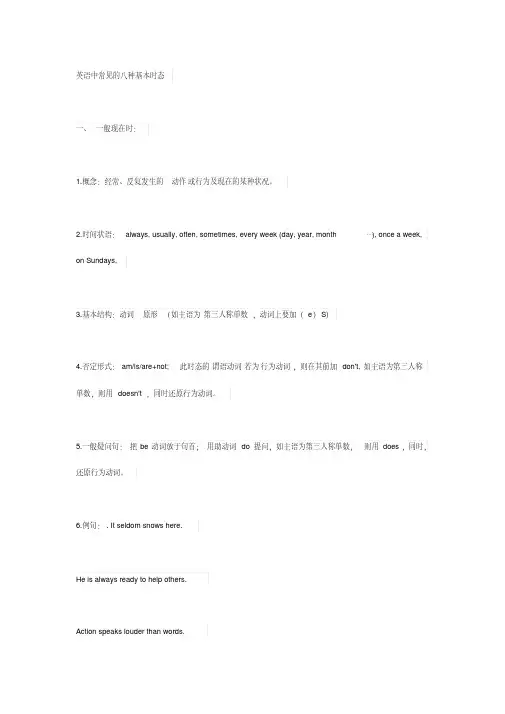
英语中常见的八种基本时态一、一般现在时:1.概念:经常、反复发生的动作或行为及现在的某种状况。
2.时间状语:always, usually, often, sometimes, every week (day, year, month…), once a week, on Sundays,3.基本结构:动词原形(如主语为第三人称单数,动词上要加(e)S)4.否定形式:am/is/are+not;此时态的谓语动词若为行为动词,则在其前加don't,如主语为第三人称单数,则用doesn't,同时还原行为动词。
5.一般疑问句:把be动词放于句首;用助动词do提问,如主语为第三人称单数,则用does,同时,还原行为动词。
6.例句:. It seldom snows here.He is always ready to help others.Action speaks louder than words.二、一般过去时:1.概念:过去某个时间里发生的动作或状态;过去习惯性、经常性的动作、行为。
2.时间状语:ago, yesterday, the day before yesterday, last week(year, night, month…), in 1989, just now, at the age of 5, one day, long long ago, once upon a time, etc.3.基本结构:be动词;行为动词4.否定形式:was/were+not;在行为动词前加didn't,同时还原行为动词。
5.一般疑问句:was或were放于句首;用助动词do的过去式did 提问,同时还原行为动词。
6.例句:She often came to help us in those days.I didn't know you were so busy.三、现在进行时:1.概念:表示现阶段或说话时正在进行的动作及行为。
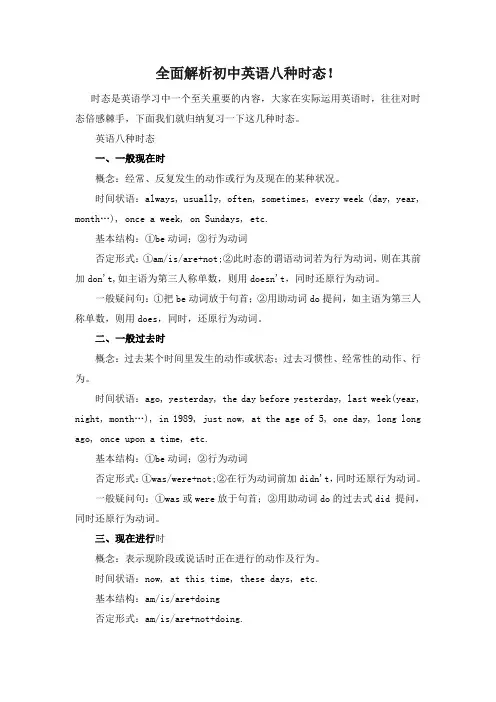
全面解析初中英语八种时态!时态是英语学习中一个至关重要的内容,大家在实际运用英语时,往往对时态倍感棘手,下面我们就归纳复习一下这几种时态。
英语八种时态一、一般现在时概念:经常、反复发生的动作或行为及现在的某种状况。
时间状语:always, usually, often, sometimes, every week (day, year, month…), once a week, on Sundays, etc.基本结构:①be动词;②行为动词否定形式:①am/is/are+not;②此时态的谓语动词若为行为动词,则在其前加don't,如主语为第三人称单数,则用doesn't,同时还原行为动词。
一般疑问句:①把be动词放于句首;②用助动词do提问,如主语为第三人称单数,则用does,同时,还原行为动词。
二、一般过去时概念:过去某个时间里发生的动作或状态;过去习惯性、经常性的动作、行为。
时间状语:ago, yesterday, the day before yesterday, last week(year, night, month…), in 1989, just now, at the age of 5, one day, long long ago, once upon a time, etc.基本结构:①be动词;②行为动词否定形式:①was/were+not;②在行为动词前加didn't,同时还原行为动词。
一般疑问句:①was或were放于句首;②用助动词do的过去式did 提问,同时还原行为动词。
三、现在进行时概念:表示现阶段或说话时正在进行的动作及行为。
时间状语:now, at this time, these days, etc.基本结构:am/is/are+doing否定形式:am/is/are+not+doing.一般疑问句:把be动词放于句首。
四、过去进行时概念:表示过去某段时间或某一时刻正在发生或进行的行为或动作。
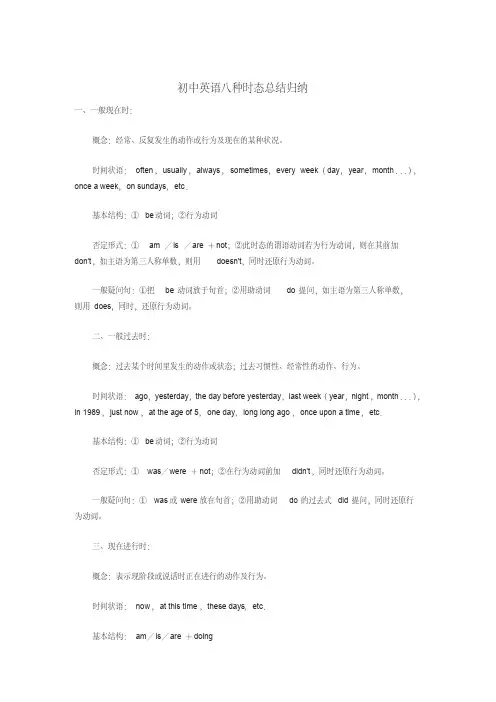
初中英语八种时态总结归纳一、一般现在时:概念:经常、反复发生的动作或行为及现在的某种状况。
时间状语:often,usually,always,sometimes,every week(day,year,month...),once a week,on sundays,etc.基本结构:①be动词;②行为动词否定形式:①am/is/are+not;②此时态的谓语动词若为行为动词,则在其前加don't,如主语为第三人称单数,则用doesn't,同时还原行为动词。
一般疑问句:①把be动词放于句首;②用助动词do提问,如主语为第三人称单数,则用does,同时,还原行为动词。
二、一般过去时:概念:过去某个时间里发生的动作或状态;过去习惯性、经常性的动作、行为。
时间状语:ago,yesterday,the day before yesterday,last week(year,night,month...),in 1989,just now,at the age of 5,one day,long long ago,once upon a time,etc.基本结构:①be动词;②行为动词否定形式:① was/were+not;②在行为动词前加didn't,同时还原行为动词。
一般疑问句:①was或were放在句首;②用助动词do的过去式did提问,同时还原行为动词。
三、现在进行时:概念:表示现阶段或说话时正在进行的动作及行为。
时间状语:now,at this time,these days,etc.基本结构:am/is/are+doing否定形式:am/is/are+not+doing一般疑问句:把be动词放在句首四、过去进行时:概念:表示过去某段时间或某一时刻正在发生或进行的行为或动作。
时间状语:at this time yesterday,at that time或以when引导的谓语动词是一般过去时的时间状语等。
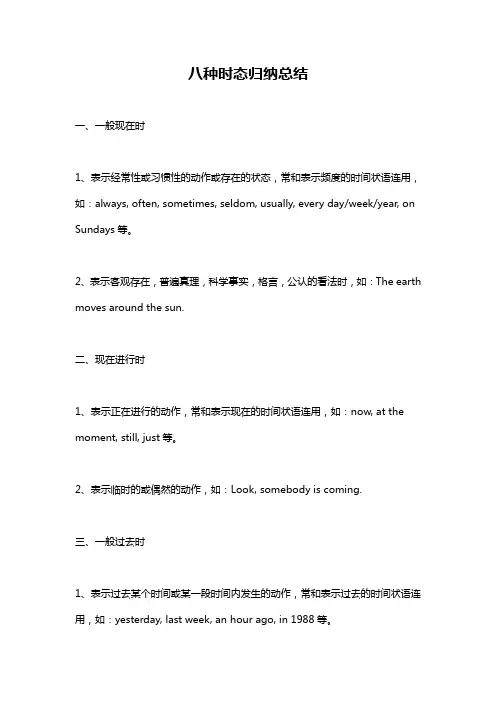
八种时态归纳总结一、一般现在时1、表示经常性或习惯性的动作或存在的状态,常和表示频度的时间状语连用,如:always, often, sometimes, seldom, usually, every day/week/year, on Sundays等。
2、表示客观存在,普遍真理,科学事实,格言,公认的看法时,如:The earth moves around the sun.二、现在进行时1、表示正在进行的动作,常和表示现在的时间状语连用,如:now, at the moment, still, just等。
2、表示临时的或偶然的动作,如:Look, somebody is coming.三、一般过去时1、表示过去某个时间或某一段时间内发生的动作,常和表示过去的时间状语连用,如:yesterday, last week, an hour ago, in 1988等。
2、表示过去经常性或习惯性的动作,如:He used to get up at 6:00 every morning.四、过去进行时表示过去某一时刻正在进行的动作,常和表示过去的时间状语连用,如:at that time, when I was a child等。
五、将来时1、表示将来某一时刻或某一段时间内发生的动作,常和表示将来的时间状语连用,如:tomorrow, next week, in two days, in June等。
2、表示将来经常性或习惯性的动作,如:He will go to work by bus every day.六、将来进行时表示将来某一时刻正在进行的动作,常和表示将来的时间状语连用,如:At that time tomorrow, next week, a month later等。
七、完成时1、表示过去发生的动作,此时此动作已经完成,常和表示过去的时间状语连用,如:yesterday, last week, in 1999等。
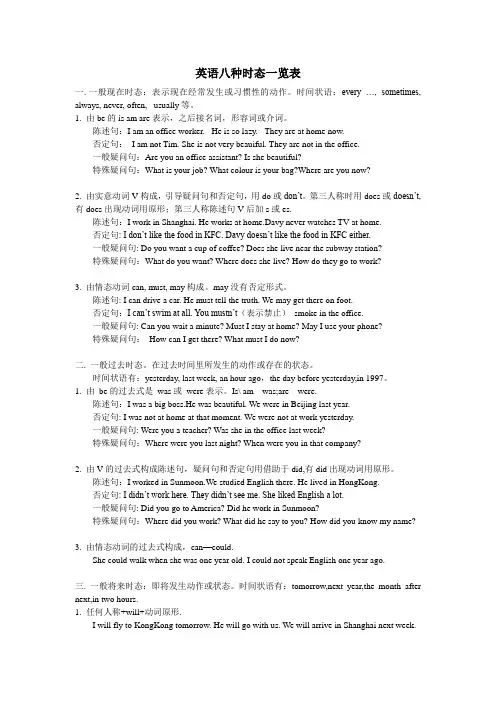
英语八种时态一览表一. 一般现在时态:表示现在经常发生或习惯性的动作。
时间状语:every …, sometimes, always, never, often, usually等。
1. 由be的is am are表示,之后接名词,形容词或介词。
陈述句:I am an office worker. He is so lazy. They are at home now.否定句:I am not Tim. She is not very beauiful. They are not in the office.一般疑问句:Are you an office assistant? Is she beautiful?特殊疑问句:What is your job? What colour is your bag?Where are you now?2. 由实意动词V构成,引导疑问句和否定句,用do或don’t。
第三人称时用does或doesn’t,有does出现动词用原形;第三人称陈述句V后加s或es.陈述句:I work in Shanghai. He works at home.Davy never watches TV at home.否定句: I don’t like the food in KFC. Davy doesn’t like the food in KFC either.一般疑问句: Do you want a cup of coffee? Does she live near the subway station?特殊疑问句:What do you want? Where does she live? How do they go to work?3. 由情态动词can, must, may构成。
may没有否定形式。
陈述句: I can drive a car. He must tell the truth. We may get there on foot.否定句:I can’t swim at all. Y ou mustn’t(表示禁止)smoke in the office.一般疑问句: Can you wait a minute? Must I stay at home? May I use your phone?特殊疑问句:How can I get there? What must I do now?二. 一般过去时态。
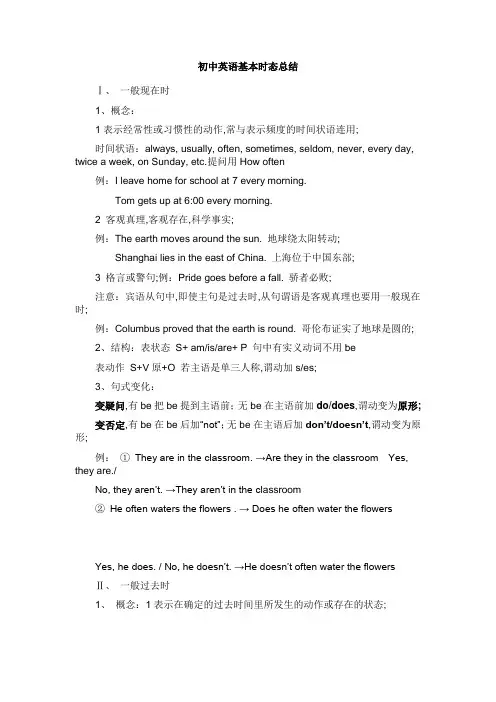
初中英语基本时态总结Ⅰ、一般现在时1、概念:1表示经常性或习惯性的动作,常与表示频度的时间状语连用;时间状语:always, usually, often, sometimes, seldom, never, every day, twice a week, on Sunday, etc.提问用How often例:I leave home for school at 7 every morning.Tom gets up at 6:00 every morning.2 客观真理,客观存在,科学事实;例:The earth moves around the sun. 地球绕太阳转动;Shanghai lies in the east of China. 上海位于中国东部;3 格言或警句;例:Pride goes before a fall. 骄者必败;注意:宾语从句中,即使主句是过去时,从句谓语是客观真理也要用一般现在时;例:Columbus proved that the earth is round. 哥伦布证实了地球是圆的;2、结构:表状态S+ am/is/are+ P 句中有实义动词不用be表动作S+V原+O 若主语是单三人称,谓动加s/es;3、句式变化:变疑问,有be把be提到主语前;无be在主语前加do/does,谓动变为原形;变否定,有be在be后加“not”;无be在主语后加don’t/doesn’t,谓动变为原形;例:①They are in the classroom. →Are they in the classroom Yes, they are./No, they aren’t. →They aren’t in the cl assroom②He often waters the flowers . → Does he often water the flowersYes, he does. / No, he doesn’t. →He doesn’t often water the flowersⅡ、一般过去时1、概念:1表示在确定的过去时间里所发生的动作或存在的状态;常用时间状语:yesterday, the day before yesterday, last week, just now, an hour ago, the other day, in 1982. at the age of 5, one day, long long ago, etc.例:Where did you go just now2表示在过去一段时间内,经常性或习惯性的动作;例:When I was a child, I often played football in the street.2、结构:表状态S+ was/were+ P表动作S+V过去式+O 注:句中有实义动词不用be3、句式变化:变疑问,有be把be提到主语前;无be在主语前加did,谓动变为原形;变否定,有be在be后直接加“not”;无be在主语后加didn’t,谓动变为原形.例:①She was in Xi’an last month. → Was she in Xi’an last monthYes, she was. /No, she wasn’t. →She wasn’t in Xi’an last month.②Danny grew a rose just now, → Did Danny grow a rose just nowYes, he did. / No, he didn’t. →Danny didn’t grow a rose just now,Ⅲ、现在进行时:1. 概念:表示现阶段或说话时正在进行的动作;时间状语:now, at this time, these days,以及有look, listen时;例:ListenThe birds are singing.2、结构:S + am/is/are + doing助动现在分词3、句式变化:变疑问,把am/is/are提到主语前;变否定,在am/is/are后直接加“not”;例:①I am writing a letter now. → Are you writing a letter nowYes, I am. /No, I’m not. →I am not writing a letter now. 注:am和not不能缩写;②The boys are playing football. → Are the boys playing footballYes, they are. / No, they aren’t. →The boys aren’t playing football.Ⅳ、过去进行时:1. 概念:表示过去某段时间或某一时刻正在发生或进行的动作;.时间状语:at this time yesterday, at that time,at 8:00 yesterday,或有when / while引导的时间状语从句等;例:We were having an English class at 9:30 yesterday morning.I was reading a book while my mother was watching TV.2、结构:S + was/were + doing3、句式变化:变疑问,把was/were提到主语前;变否定,在was/were后直接加“not”;例:①At that time they were working in the garden. → Were they working inthe garden at that timeYes, they were. / No, they weren’t.→At that time they were working in the garden.②When he came in, I was reading a newspaper. →When he came in, were you reading a newspaperYes, I was. / No, I wasn’t.→When he came in, I wasn’t reading a newspaper.Ⅴ、一般将来时1. 概念:表示将要发生的动作或存在的状态;时间词:tomorrow, tomorrow morning, at seven o'clock tomorrow evening, next year, this year, at the end of this term, from now,in ten minutes, in 2025例:They will do an experiment tomorrow afternoon.Brian is going to draw twenty pictures at the end of this term.2、结构:S +will+ V原+其他will 可改为be going to ,当主语是第一人称时will可用shall例:Which paragraph shall I read first 我先读哪一段呢Will you/Are you going tobe at home at seven this evening3、句式变化:变疑问,把will提到主语前;变否定,在will后直接加“not”;例; She will drive to Beijing next week. → Will she drive to Beijing next weekYes, she will. / No, she won’t. →She won’t drive to Beijing next week.★be going to + V原表示a. 主语的意图,即将做某事;例:What are you going to do tomorrowb. 计划,安排要发生的事;例:The play is going to be produced next month;c. 有迹象要发生的事;例:Look at the dark clouds, there is going to be a storm.★be +不定式:表示将来,按计划或正式安排将发生的事;例:We are to discuss the report next Saturday. 我们下星期六将讨论这份报告★用现在进行时表示将来come, go, arrive, leave, start, begin, return等终止性动词可用现在进行时表示将来;例:I'm leaving tomorrow. 明天我要走了;Are you staying here till next week 你会在这儿呆到下周吗Ⅶ、现在完成时:1. 表示:①过去发生或已经完成的动作对现在造成的影响或结果;时间词:ever, never, already, yet, before, just, recently/ lately最近, in the past few years2. ②或从过去已经开始持续到现在的动作或状态; 时间词:for + 时间段,since +过去时间点/从句;提问用How long例:The countryside has changed a lot in the past few years.He has learned French for two years.2.结构:S + have/has + done助动过去分词3. 句式变化:变疑问,把have/has提到主语前;变否定,在have/has后直接加“not”;例:①I've already written an article. → Have you written an article yet Yes, I h ave. / No, I haven’t. →I haven’t written an article yet.②Li Ming has lived in Shijiazhuang since 1993.→ Has Li Ming lived in Shijiazhuang since 1993 Yes, he has. / No, he hasn’t.→Li Ming hasn’t lived in Shijiazhuang since 1993.★比较一般过去时与现在完成时1一般过去时表示过去某具体时间发生的动作或单纯叙述过去的事情,强调动作;现在完成时则强调过去发生的动作对现在的造成影响,强调的是结果;2一般过去时常与具体的时间状语连用,而现在完成时通常与模糊的时间状语连用,或无时间状语;例:I saw this film yesterday. 强调看的动作发生过了I have seen this film. 强调对现在的影响,电影的内容已经知道了Why did you get up so early 强调起床的动作已发生过了Who hasn't handed in his paper 强调有卷子未交,指结果He joined the League three years ago. 强调加入这一动作He has been a League member for three years. 是团员的状态可持续句子中如有过去时的时间副词如yesterday, last, week, in 1960时,不能使用现在完成时,要用过去时;错Tom has written a letter to his parents last night.对Tom wrote a letter to his parents last night.。
常用的八种时态:一般现在时、一般过去时、现在进行时、过去进行时、一般将来时、过去将来时、现在完成时、过去完成时。
1.一般现在时1)一般现在时态的构成:主语是I,we,you,they和名词复数时作谓语的行为动词用原形。
2)常用于一般现在时态的时间状语:often、usually、sometimes、always、every、day、never、in、the、morning等。
2.现在进行时1)现在进行时的构成:Am/is/are+v-ing是现在进行时的构成形式。
2)现在进行时的用法:1.说话时正在进行或发生的动作(动作是在说话时正在进行);2.现阶段正在进行或发生的动作(但是动作并不是必须在说话时正在进行)。
3.一般将来时1)一般将来时的构成:1.助动词will(shall)+动词原形2.am/is/are+going to+动词原形2)一般将来时的用法:1.将要发生的动作。
2.将要存在的状态。
3.打算要做的事。
3)常用于一般将来时的时间状语:tomorrow、next、week、in2008等。
4.一般过去时1)一般过去时的构成:用动词的过去式。
3)一般过去时的用法:1.过去发生的动作。
2.过去存在的状态。
3)常用于一般过去时的时间状语:yesterday,three months ago,last year,in1979,often,always等。
5.现在完成时1)现在完成时的构成:have/has+v-ed2)现在完成时的用法:1、表示过去发生的动作对现在造成的影响或结果.常与already,just,ever,never,before等词连用.2、表示“过去的动作”一直延续到现在并有可能继续延续下去.常与for(后跟段时间)或since(后跟点时间)等连用.6、过去进行时1)过去进行时的构成:was/were+v-ing2)过去进行时的用法:过去某一阶段或某一时刻正在进行的动作。
例如:This time last year I was living in Brazil.3)常用于过去进行时的时间状语:at four yesterday afternoon,then,at that time/moment等。
初中八种时态的组成及经常使历时刻状语对照表、一样此刻时(一)概念表示常常性或适应性的动作,或存在的状态,还表示主语具有的性格和能力及客观真理。
例:I get up at 6:30 in the morning .She is at home .(二)组成要紧用动词原形表示,当主语是第三人称单数时,在动词词尾加s/es。
(三)句型一、确信句:主语+谓语+其他。
She reads English everyday .二、否定句:主语+don’t/doesn’t+谓语+其他。
He doesn’t get up at 6:30 in the morning .3、一样疑问句:Do/Does+主语+V原+其他?Do you like English ? Yes ,I do ./No, I don’t .4、特殊疑问句:特殊疑问词+do/does+主语+V原+其他?What time do you get up every morning ?Where does your father work ?(三)用法一、表示常常性或适应性的动作,或存在的状态,带与表示频率的时刻状语如:often , sometimes , usually,always , everyday year,month...), once/twice a week (month , year , etc.) , seldom , on sundays等连用。
I leave home for school at seven every morning .二、表示客观真理,科学事实、格言警语。
The sun rises in the east .日出东方。
The earth goes around the sun .地球绕着太阳转。
Ten minus two is eight.十减二等于八。
Light travels faster than sound .光的速度比声音的速度快。
初中八种重要时态常用的时间状语一、The Present Indefinite Tense(一般现在时)(一)句型转换。
1、含be动词的句型转换肯定句:S2+is+.../I+am+.../S1+are+...否定句:S2+is + not +.../I+ am +not+.../S1 +are +not+...一般疑问句:Is +S2+...?肯定回答:Yes,he/she/it is.否定回答:No,he/she/it isn't.Am+I/Are+you+...?肯定回答:Yes,I am./否定回答:No,I'm not.Are +S1+...?肯定回答:Yes, we/you/they are.否定回答:No,we/you/they aren't.2、含实意动词do的句型转换肯定句:S2 +does.../S1+ do...否定句:S2+doesn't +do+.../S1+don't + do+...一般疑问句:Does+S2+do+...?肯定回答:Yes,he/she/it does. 否定回答:No,he/she/it doesn'tDo +S1+do+...?肯定回答:Yes,I/we/you/they do./否定回答:No,I/we/you/they don't.3、含实意动词V的句型转换肯定句:S2 +Ves.../S1+ V...否定句:S2+doesn't +V+.../S1+don't + V+...一般疑问句:Does+S2+V+...?肯定回答:Yes,he/she/it does. 否定回答:No,he/she/it doesn'tDo +S1+V+...?肯定回答:Yes,I/we/you/they do./否定回答:No,I/we/you/they don't.4、含there be动词的句型转换肯定句:There is...There are否定句:There is not...There are not...一般疑问句:Is there ...?肯定回答:Yes,there is.否定回答:No,there isn'tAre there ...?肯定回答:Yes,there are.否定回答:No,there aren't.注意:肯定句改为一般疑问句时:①I/we/me/us→you,my/our→your,mine/ours→yours),三人称不变), ②改be 动词的am为are,改句号为问号),③改相应的词(some→any,and→or,very much/a lot/a little→at all)(S1第一类主语):除三人称单数外的代词I/you/we/they相当于we/you/they的专有名词(Lucy and I(we), you an Lily(you),Lucy and Lily(they)和相当于they的复数名词(these boys/men/birds等时,在一般现在时,动词用原形(S2第二类主语):三人称单数代词he/she/it,相当于he/she/it的单个人名/地名Lucy(she),Jim(he) China(it)及相当于he/she/it的名词this boy(he)that girl (she) the cat(it)等,在一般现在时中,动词用三单现。
初中英语语法八种基本时态归纳阶段是学英语的黄金期,学生到底该怎么学英语才最有效呢?下面是小偏整理的初中英语语法八种基本时态归纳,感谢您的每一次阅读。
初中英语语法八种基本时态归纳1.一般现在时概念:表示经常发生的动作或经常存在的状态。
常和always,often,usually,sometimes,everyday等表时间的状语连用。
如:1)Igotoschooleveryday.我每天都去学校。
(表经常)2)Heisalwayslikethat.他总是那样。
(表状态)构成:1)主语+be(am/are/is)+……2)主语+实义动词/三单动词+…2.一般过去时概念:1)表示过去某个时间发生的动作或存在的状态.常和表示过去的时间状语连用.如:yesterday,lastweek,in1998,twodaysago等.如:Iwenttoamovieyesterday.我昨天去看了一场电影.2)也可表示过去经常或反复发生的动作.如:Healwayswenttoworkbybikelastweek.构成:1)主语+be(was/were)+……2)主语+实义动词过去式+3.现在进行时概念:表示现在(说话瞬间)正在进行或发生的动作.如:Heissinging.TheyarewatchingTVnow.构成:主语+助动词be(am/are/is)+动词-ing形式构成.4.过去进行时概念:表示过去某一时刻或某一段时间正在进行的动作.这一特定的过去时间除了有上下文暗示外,一般用时间状语来表示.如:1)---Whatwereyoudoing?---Iwasjumping.2)---WhatwastheboydoingwhentheUFOarrived?---Hewassleeping.构成:主语+助动词be(was/were)+动词-ing形式构成.5.一般将来时概念:表示将来某个时间要发生的动作或存在的状态,也表示将来经常或反复发生的动作,常与表示将来的时间状语连用,如:tomorrow,nextweek,nextyear,inthefuture等.如:Hewillgoshoppingtomorrow.Theyaregoingtoplaybasketballnextweek.构成:1)主语+助动词will+动原+…2)主语+begoingto+动原+….6.过去将来时概念:表示在过去将来的某一时间发生的动作或存在的状态.构成:1)主语(第一人称)+助动词should+动原+…2)主语+would+动原+….3)主语+was/weregoingto+动原…用法:过去将来时除了上下文暗示外,一般常用在间接引语中,主句谓语动词为过去时态.如:1)Ishouldgo.2)YouknewIwouldcome.3)TheyweregoingtoNaning.7.现在完成时构成:主语+助动词(have/has)+动词过去分词+…用法例句表示过去发生或已经完成的动作对现在造成的影响或结果.---Haveyouhadyourlunchyet?---Yes,Ihave.(现在我不饿了)8.过去完成时构成:主语+助动词had+动词过去分词+…用法例句表示过去在过去某一时间或动作之前已经发生或完成了的动作.它表示的动作发生的时间是”过去的过去”.表示过去某一时间可用by,before等构成的短语,也可用when,before,等引导的从句或者通过上下文表示.Ihadfinishedmyhomeworkwhenmymomcamebackhome.怎么学英语进步快阶段是学英语的黄金期,小学生到底该怎么学英语才最有效呢?为了家长和孩子们少走弯路,给大家支一招:学英语,从家庭环境的角度,有两个方法非常有效。
初中英语必须掌握的8大时态英语八大时态:一. 一般现在时标志:动词原形1. 表示经常性或习惯性动作,常与表频度的时间状语连用:She often speaks English.I leave home for school at 7 every morning.2. 表示现在的状态、特征、职业、能力、感觉等:He seems to feel a bit down today.He works as a driver.3. 表示真理、客观存在、科学事实或用于格言警句中:Shanghai lies in the east of China.Columbus proved that the earth is round.Where there is a will, there is a way.4. 表示现在瞬间的动作:Here comes the bus!5. 表示将来1) 表按规定、计划、安排将要发生的动作(仅限于某些表示“来、去、动、停、开始、结束、继续”等的趋向动词),可以与表示未来的时间状语搭配使用。
常见的用法是:飞机、火车、轮船、汽车等定期定点运行的交通状况。
如:The next train leaves at 3 o’clock this afternoon.How often does the shuttle bus run?2) 在时间和条件状语从句中常使用一般现在时表示将来发生的事情:When Bill comes (不用will come), ask him to wait for me.I shall go there tomorrow unless I’m too bus y.二. 一般过去时标志:动词过去式*闭音节:元音字母a, e, i, o, u如果发字母本来的音则称为开音节,否则称为闭音节。
1. 表示过去某时所发生的动作或存在的状态,常与表示过去的时间状语连用(e.g. yesterday, this morning, just now, a moment ago, in May, last night/year / week, once upon a time, the other day, before …,when …, in the past等)。
5、八种时态的具体用法:(1)一般现在时表示现阶段经常或习惯发生的动作或存在的状态,或说明主语的特征。
①一般现在时句子中常有的时间状语:often,usually,sometimes,always,every(day等), once/twice,a (week等), on (Sunday等),never,in the (morning等)。
如:They go to the Palace Museum once a year.(他们每年去一次故宫)/ They oftendiscuss business in the evening.(他们经常在晚上商谈生意)②表示客观真理、事实、人的技能或现在的状态时句子里一般不用时间状语。
如:The earth turns round the sun.(地球绕着太阳转)/ Light travels faster thansound.(光传播比声音快)③表示十分确定会发生(如安排好的事情)或按照时间表进行的事情,用一般现在可以表达将来,句子中可以有将来时间。
如:The train for Haikou leaves at 8:00 inthe morning.(开往汉口的列车上午8点开车)④在时间状语从句中(以when, after, before, while, until, as soon as等引导)和条件状语从句中(以if,unless引导),用一般现在时代替一般将来时,句子可以有将来时间。
如:Please ring me up as soon as you arrive in Germany.(你一到德国就给我打电话) / If it rains tomorrow,we will have to stay at home.(如果明天下雨我们就只好呆在家)⑤一般现在时用于倒装句中可以表示正在发生的动作,动词以come, go为主。
如:Here comes the bus. (车来了) / There goes the bell.(铃响了)。
英语中八种常见时态常用时间状语归纳一、一般现在时1. 概念:表示现阶段经常发生的动作或现在的某种状况,也表示客观事实、客观规律或客观真理。
谓语动词要用原形,主语是第三人称时,谓语动词要用第三人称单数形式。
2. 常见时间状语标志:always, often, sometimes, usually, every day, on Sundays, once a day / week / month等。
例如:I do some exercise every day. 我每天做一些锻炼。
She knows French and German besides English.除英语外,她还懂法语和德语。
The sun rises in the east. 太阳从东边升起。
二、一般将来时1. 概念:表示将来发生的动作或存在的状态,以及打算、计划或准备做某事。
2. 常见时间状语标志:tomorrow, the day after tomorrow, next day / week / month / year…, this week / month / year, soon, in + 时间状语(如in one hour / in a few minutes等),in the future, in future等。
例如:I’ll take you there tomorrow. 我明天带你去那儿。
Next month we will have our school open day. 下个月我们将迎来学校开放日。
The Talent Show is coming in two weeks’ time. 新秀选拔演出还有两周时间就要到了。
三、一般过去时1. 概念:表示在过去的某个时间发生的动作或存在的状态,也表示过去习惯性、经常性的动作。
谓语动词要用过去时。
2. 常见时间状语标志:yesterday, the day before yesterday, last night / week / month, 时间词+ ago (如three days ago), in / on + 过去的时间词(如in 2010), just now, at that time, in those days, one day, long long time ago, once upon a time等。
例如:Two years ago she bought an expensive mountain bike.两年前,她买了一辆昂贵的山地自行车。
Last year, however, nearly twenty billion tons of rice was produced. 然而,去年的稻谷产量接近200亿吨。
四、现在进行时1. 概念:表示现在正在进行的动作,或现阶段正在进行的动作。
现在进行时由“am / is / are + 现在分词”构成。
2. 常见时间状语标志:now, at this time, at this moment, at present等。
例如:Now she is planning our schedule for the trip. 现在她正在为旅行制定时间表。
Today the number of people learning English in China is increasing rapidly. 当今在中国学习英语的人数正在迅速增长。
注意:不用进行时的动词:①表示感官的动词:如see (看见),hear (听见),feel (感觉出),taste (尝出),smell (闻到),notice (注意到),observe (观察到) 等。
②表示某种情感或精神状态的动词:如believe, doubt, feel (= have an opinion), hate, image, know, (dis)like, love, prefer, realize, appreciate, recognize, remember, see (= understand), suppose, think (= have an opinion), understand, want, wish等。
③一些用于交际和应答的动词:如agree, appear, astonish, deny, disagree, impress, look (= seem), mean, please, promise, satisfy, seem, surprise等。
④表示所属、类似、构成等关系的动词和系动词,如:be, belong, concern, consist, contain, depend, deserve, fit, include, involve, lack, matter, measure (= have length etc.), need, owe, own, possess, weigh (= have weight)。
五、过去进行时1. 概念:表示过去某时刻正在进行的动作,或过去某一阶段一直在进行的动作,过去进行时由“was / were + 现在分词”构成。
2. 常见时间状语标志:(just) then, at that time, yesterday afternoon, the whole morning, all day yesterday, from 9 to 10 last evening / night, those days等。
例如:May I ask what you were doing in my restaurant yesterday? 请问你昨天到我的餐馆里来干什么?It was a cold day and his jacket was lying on the back of a chair. 天很冷,他的夹克衫搭在椅背上。
3. 过去进行时和一般过去时的区别:过去进行时表示过去某时正在进行的动作,强调动作的连续性;而一般过去时则表示一个完成的动作。
六、现在完成时1. 概念:1) 表示动作发生在过去,但其结果影响到现在。
常见时间状语标志:already, yet, just, ever, recently, so far, up to / till now等。
2) 表示动作或状态从过去某一时刻开始,一直持续到现在,还可能持续下去。
常见时间状语标志:for + 时间段, since + 时间点/ 过去时从句, ever since等。
3) 表示说话前发生过一次或多次的动作,现在成为一种经历。
常见时间状语标志:twice, ever, never, three times, before等。
2. 基本结构:have / has + 动词的过去分词。
3. 注意:非延续性动词不能用“现在完成时+ 表示一段时间的状语”的句型中。
这些动词有:come, go, start, leave, die, buy, finish, join, borrow, stop等。
但它们能够用表示持续状态的相应的延续性动词替换句中的非延续性性动词。
如:arrive, come → be here, be inbuy → havebegin, start → be ondie → be deadgo out → be outjoin → be inborrow → keepfinish, end → be overclose → be closedleave, move → be awayfall asleep → be asleep4. 现在完成时与一般过去时的区别:现在完成时和一般过去时都表示过去发生的动作。
差别在于:现在完成时强调的是动作与现在的关系,即对现在的影响或动作延续到现在;而一般过去时只表示动作在过去某时发生,不表示和现在有关系。
因此,句中有过去时间状语时,一般用一般过去时。
试比较:I have lost my new bike. 我把新自行车丢了。
(现在还未找到)I lost my new bike yesterday. 我昨天把新自行车丢了。
(现在找到与否不清楚)He worked there for three years. 他在那里工作了3 年。
(现在已不在那里工作)He has worked there for three years. 他在那里工作已3 年了。
(现在仍在那里工作)5. 注意: have / has gone to, have/has been to 和have / has been in的区别:have / has gone to 表示人在去某地的路上或在某地,还未回来;have / has been to 表示人曾经去某地,并且人已经回来了;have / has been in 表示人已经在某地,常与一段时间连用。
七、过去完成时1. 概念:表示以过去某个时间为标准,在此以前发生的动作或行为,或在过去某动作之前的行为,即“过去的过去”。
2. 常见时间状语标志:before, by the end of last term / week / month / year 等。
例如:Most of the guests had left when he arrived at the party. 当他到达晚会现场时,大多数客人已经离开了。
By the 1990s the number had fallen to about 50,000. 截止到20世纪90年代,(藏羚羊的) 数量下降到了大约5万只。
Before he volunteered to direct the traffic, Timoteo had had lots of jobs. 铁穆特欧在志愿指挥交通之前做过很多工作。
八、过去将来时1. 概念:表示从过去某个时间看即将发生的动作或存在的状态。
过去将来时由“should / would + 动词原形”构成。
2. 常见时间状语标志:通常在宾语从句中出现,主句谓语动词为过去时态。
例如:She said she would be there at seven o’clock, and he thought she would keep her word. 她说她会在7点到达,他认为她会守信用的。
They always told us that one day we would move into a house, a real house that would be ours. 他们那时总是跟我们说总有一天我们会搬进一所房子,一所真正属于我们的房子。